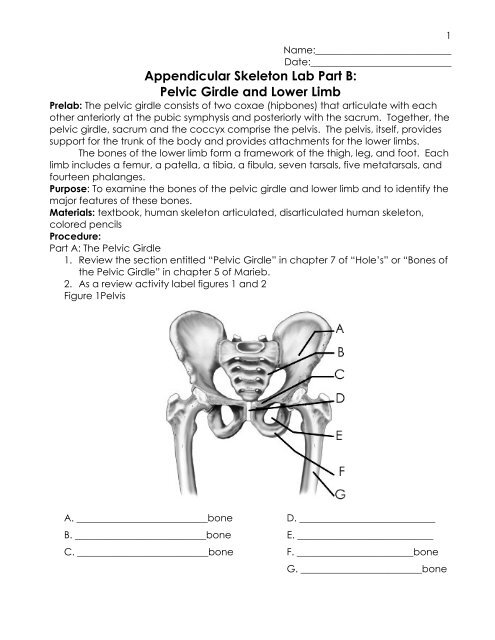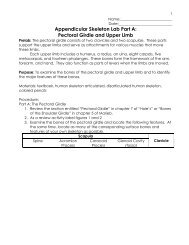Appendicular Skeleton Lab Part B: Pelvic Girdle and ... - MSAD #54
Appendicular Skeleton Lab Part B: Pelvic Girdle and ... - MSAD #54
Appendicular Skeleton Lab Part B: Pelvic Girdle and ... - MSAD #54
You also want an ePaper? Increase the reach of your titles
YUMPU automatically turns print PDFs into web optimized ePapers that Google loves.
Name:____________________________<br />
Date:_____________________________<br />
<strong>Appendicular</strong> <strong>Skeleton</strong> <strong>Lab</strong> <strong>Part</strong> B:<br />
<strong>Pelvic</strong> <strong>Girdle</strong> <strong>and</strong> Lower Limb<br />
Prelab: The pelvic girdle consists of two coxae (hipbones) that articulate with each<br />
other anteriorly at the pubic symphysis <strong>and</strong> posteriorly with the sacrum. Together, the<br />
pelvic girdle, sacrum <strong>and</strong> the coccyx comprise the pelvis. The pelvis, itself, provides<br />
support for the trunk of the body <strong>and</strong> provides attachments for the lower limbs.<br />
The bones of the lower limb form a framework of the thigh, leg, <strong>and</strong> foot. Each<br />
limb includes a femur, a patella, a tibia, a fibula, seven tarsals, five metatarsals, <strong>and</strong><br />
fourteen phalanges.<br />
Purpose: To examine the bones of the pelvic girdle <strong>and</strong> lower limb <strong>and</strong> to identify the<br />
major features of these bones.<br />
Materials: textbook, human skeleton articulated, disarticulated human skeleton,<br />
colored pencils<br />
Procedure:<br />
<strong>Part</strong> A: The <strong>Pelvic</strong> <strong>Girdle</strong><br />
1. Review the section entitled “<strong>Pelvic</strong> <strong>Girdle</strong>” in chapter 7 of “Hole’s” or “Bones of<br />
the <strong>Pelvic</strong> <strong>Girdle</strong>” in chapter 5 of Marieb.<br />
2. As a review activity label figures 1 <strong>and</strong> 2<br />
Figure 1Pelvis<br />
A. ___________________________bone D. ____________________________<br />
B. ___________________________bone E. ____________________________<br />
C. ___________________________bone F. ________________________bone<br />
G. _________________________bone<br />
1
Figure 2 Split Pelvis<br />
A.____________________________ F._______________________________<br />
B.____________________________bone G._______________________________<br />
C.____________________________ H.______________________________bone<br />
D.____________________________ I.______________________________Bone<br />
E.____________________________bone<br />
3. Examine the bones of the pelvic girdle <strong>and</strong> locate the following bones <strong>and</strong><br />
features.<br />
acetabulum Ischial ramus<br />
Ilium Ischial spine<br />
Iliac crest Pubis<br />
Greater sciatic notch Pubic symphysis<br />
Ishium Obturator foramen<br />
4. Complete part A of the conclusion.<br />
2
<strong>Part</strong> B: the Lower Limb<br />
1. Review the section entitled “Lower Limb” in chapter 7 of “Hole’s” <strong>and</strong> “Bones<br />
of the Lower Limb” in chapter 5 of Marieb.<br />
2. As a review activity, label figures 3-6.<br />
Figure 3 The Femur<br />
A.____________________________ D.____________________________<br />
B.____________________________ E.____________________________<br />
C.____________________________ F._______________________________<br />
3
Figure 4 Lower leg<br />
A.____________________________bone E.____________________________<br />
B.____________________________bone F._______________________________<br />
C.____________________________ G._______________________________<br />
D.____________________________<br />
4
Figure 5 Foot (superior)<br />
A. ____________________________ E. ____________________________<br />
B. ____________________________ F. ____________________________<br />
C. ____________________________ G. ____________________________<br />
D. ____________________________ H. ____________________________<br />
5
Figure 6 Foot (Lateral)<br />
A.____________________________ E.____________________________bone<br />
B.____________________________ I.______________________________Bone<br />
C.____________________________ J.______________________________Bone<br />
D.____________________________bone<br />
3. Examine the following bones <strong>and</strong> features of the lower limb:<br />
Femur Tibia<br />
Head Anterior crest<br />
neck Tibial tuberosity<br />
Greater trochanter Medial malleolus<br />
Lesser trochanter Tarsal bones<br />
Lateral condyle Talus<br />
Medial condyle Calcaneus<br />
Fibula Metatarsal bones<br />
head Phalanges<br />
Lateral malleolus Proximal<br />
middle<br />
distal<br />
4. Use colored pencils to distinguish individual bones in each figure 1-6 Use<br />
different colors to represent the regions you are responsible for on the<br />
practical.<br />
5. Complete part B of the conclusion<br />
6
Conclusion:<br />
<strong>Part</strong> A: Complete the following statements.<br />
1. The pelvic girdle consists of two ______________________________.<br />
2. The head of the femur articulates with the ______________________________ of the<br />
coxae.<br />
3. The __________________________________________ is the largest portion of the coxa.<br />
4. The pubic bones come together anteriorly to form the joint called the<br />
_________________________________________.<br />
5. The _______________________________________ is the portion of the ilium that causes<br />
the prominence of the hip.<br />
6. When a person sits, the ____________________________________ of the ischium<br />
supports the weight of the body.<br />
7. The ___________________________________ is the largest foramen of the skeleton.<br />
8. The ilium joins the sacrum at the __________________________________ joint.<br />
<strong>Part</strong> B: Match the bones in column b with the features in column A. Place the letter<br />
of your choice in the space provided.<br />
Column A Column B<br />
______1. Lesser trochanter A. femur<br />
______2. medial malleolus B. fibula<br />
______3. Lateral condyle C. metatarsals<br />
______4. Calcaneus D. tarsals<br />
______5. 7 bones of the ankle E. Tibia<br />
______6. Talus F. phalanges<br />
______7. lateral malleolus<br />
______ 8. 5 bones that form the in step<br />
______9. The big toe has only 2<br />
______10. Anterior crest<br />
______11. neck<br />
______12. Head (could be 2 bones)<br />
7



